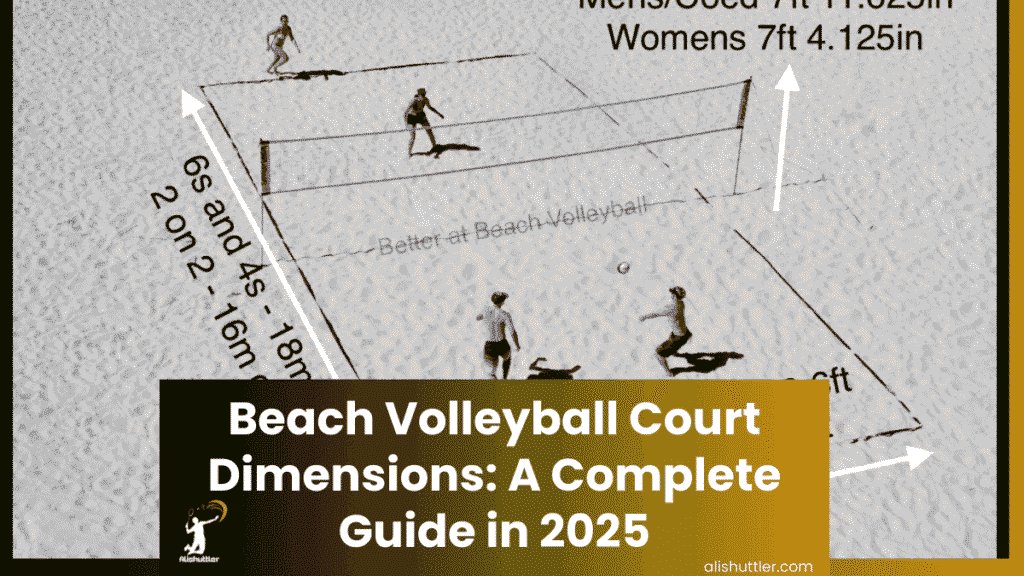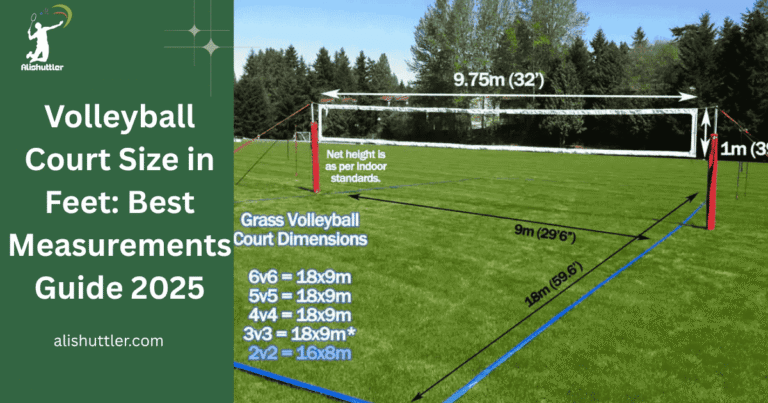Beach Volleyball Court Dimensions are 16 meters long and 8 meters wide for official competition. These dimensions help ensure fairness in the game and provide ample room for each team.
The court is marked with boundary lines, and there is no center line. Some folks use smaller spaces for casual games, but most stick with the norm.
Knowing these details can help players, coaches and event organizers set up games that align with the rules.
Official Dimensions
Beach volleyball courts are regulated in size by international organizations to standardize competition and protect the welfare of athletes. Court dimensions and space around them impact game tempo, player comfort and fairness of competition.

The following list outlines the primary dimensions and requirements:
- The official court size is 16m x 8m (52ft 6in x 26ft 3in) as opposed to indoor volleyball which is 18m x 9m (59ft 6in x 29ft 6in).
- The free zone, or buffer surrounding the court, must be no less than 5m (16ft 5in) wide on each side for competition, with a recommended width of 6m (20ft) to facilitate free movement and limit injuries.
- Sidelines and end lines surround the court’s perimeter, defining in-play and out-of-play balls. These lines need to be very obvious, typically with florescent tape or cord.
1. Court Length
The official beach volleyball court measures 16 meters (52’6”) in length. It’s shorter than the 18 meters in indoor volleyball, which affects how players position themselves and run during a rally.
At 16 meters long, your players have a lot more ground to cover each—particularly with 2-on-2 play—each side is an 8m x 8m square. Precision court length is crucial for top level tournaments, since even minor variations can alter teams’ defensive or offensive strategies.
Referees actually inspect and measure the court prior to matches, ensuring it conforms to regulations so that all teams are playing under equal circumstances.
2. Court Width
Beach volleyball courts are 8 meters wide (26’3”). This width is less than indoor volleyball, which is 9 meters. That compressed area translates to more ball touches and faster side to side action.
Players have to adapt their strategies. Teams typically employ communication and spacing to cover the court effectively. Correct width is for fair play – it guarantees that everyone plays in the same boundaries and there are no arguments about out-of-bounds calls.
The width joins with the 16-meter length to make up the court’s rectangle. This is the case for every official match.
3. Free Zone
A free zone not less than 5m (16ft 5in) wide surrounds the court though 6m (20ft) is the recommended space at international events. This space gives players a cushion to pursue balls and maintain safe play.
A crowded free zone is dangerous and restricts athletic movement. If you have multiple courts side by side, each requires its own free zone to prevent match interference. FIVB events are held under strict standards, with minimum at 5m and an aim of 6m.
4. Sand Depth
The optimal sand depth of a beach volleyball court is approximately 40 cm (16 inches). This depth cushions landings and allows athletes to accelerate and decelerate comfortably, minimizing impact on joints and preventing injuries.
Shallow or inconsistent sand leads to uneven footing or rough play. Okay, clear, rock and detritus free sand is the best for maximum comfort and performance.
Organizers have to shovel the sand depth even across the surface so that each team competes under the same conditions.
The 2×2 Court
2×2 court A smaller play area, set up for 2 players on each side. It’s not an arbitrary size. 2×2 court standards are 16 meters x 8 meters (52.5 feet x 26.25 feet). This is the identical scoring you’ll observe in pro beach volleyball internationals for doubles matches.
For contrast, an indoor volleyball court is larger, measuring 18 m by 9 m (59′ x 29.5′). Designed for leaner rosters, the 2×2 court makes games more ferocious, with players covering more court.
| Court Type | Dimensions (meters) | Dimensions (feet) | Main Use |
|---|---|---|---|
| Standard Indoor | 18 x 9 | 59 x 29.5 | Indoor, 6 players per side |
| Standard Beach (2×2) | 16 x 8 | 52.5 x 26.25 | Outdoor/sand, 2 players per side |
| Mini/Youth 2×2 | 16 x 8 (or less) | 52.5 x 26.25 (or smaller) | Young, practice, funnies |
The 2×2 court is used for recreational and competitive play alike. A lot of local leagues adopt this model because it’s simpler to organize in parks, on beaches, or even in backyards.
In certain tournaments, primarily for younger players or camps, abbreviated courts are employed to assist novice players in acclimating to the game. For instance, a youth camp might opt for a slightly shrunken 2×2 court to make the game less intimidating to novices.
Even at the pro level, doubles matches on sand utilize the 16 x 8 meter arrangement, demonstrating that this court size caters to everyone from novices to world-class athletes.
One huge advantage of the 2×2 court is the way it nurtures player development. With only two people per team, you can’t hide. Players must hustle and react fast, spanning the entire court with only a single partner.
This environment forces players to improve on their ball reading, decision making and awareness. Serving and spiking receive more coverage as well, because every point can change the momentum of an entire match.
It’s a popular training tool among coaches for its ability to simultaneously build agility, teamwork and sharp thinking. A decreased court can also signify a smaller free zone—the area surrounding the lines where players can pursue balls—which generates speedier back-and-forth and less dead air.
Net Specifications
Beach volleyball nets adhere to rigid specifications, including the precise volleyball net height, to ensure fair play in the competitive beach volleyball game. These guidelines encompass materials, form, positioning, and size, all contributing to the integrity of the sport, distinguishing beach volleyball from the indoor volleyball court.
Net Height
The formal net height in international and most other national competitions is 2.43 meters (7′ 11 5/8″) for men, and 2.24 meters (7′ 4 1/8″) for women. The net’s height at the sidelines may be up to 19 mm (3/4″) above these standards. Even a small difference matters because it influences game strategies, as the net height informs both offensive and defensive approaches.
Players customize their jumping, serving and blocking strategies according to the net’s precise height. For junior, recreational or adaptive leagues, net heights are different to appropriate skill and safety requirements. Lower nets let younger or less skilled players attack effectively without risking injury and higher nets encountered in adult play promote more sophisticated strategies.
Keeping the net at the right height is essential so that competition remains fair and one side doesn’t have an advantage over the other.
Net Structure
Beach Volleyball Court Dimensions net includes a tough mesh, side bands, tensioning cables and two antennas. The mesh is usually synthetic fiber, like polyethylene or nylon, selected for its durability in sun, sand and moisture. The mesh is just fine enough to keep the ball from slipping through but doesn’t trap sand or water.
Tensioning systems, typically steel cables or heavy-duty ropes, extend along the top and bottom, keeping the net stretched between poles. Side bands support the net’s vertical edges, and antennas rise 1.8 meters (5’11”) above the net and measure 22 millimeters in thickness. Antennas line the sidelines, allowing players and referees to make in-bounds and out-of-bounds calls.
Beach nets differ from indoor nets in both materials and structure: indoor nets use fabrics more suitable for controlled environments, and their posts anchor into gym floors, not sand. Strong construction is essential for outdoor nets, which have to withstand strain and changeable weather.
Post Placement
Net posts are positioned outside the sidelines, embedded a minimum of 1.5 metres (five feet) into the sand. This depth helps keep the net from sagging or shifting during hard play or windy conditions. Ideally, the distance from each post to the nearest sideline would be at least 0.91 meters/three feet, giving the players a safe zone and minimizing injury risks.
Posts could be 4×4, but they’re likely to bend or crack after a while from the tension. Stable, strategically-placed posts are important for maintaining net height and tension. A loose or improperly secured post will cause a sagging net and/or unexpected ‘flop’ down and endanger the game as well as players.
Indoor Beach Volleyball Court Dimensions: posts, unlike outdoor setups, are typically embedded into the floor, giving rise to different standards of post installation and safety.
Set Structure
Beach Volleyball Court Dimensions matches have definite rules for sets and scoring. Best-of-three sets is the predominant format at the international level, but a few tournaments and age groups implement a best-of-five format. Each set structure determines the flow of the match and how teams strategize about their play.
The regular three-set format is employed in nearly all world events, such as in the Olympics and FIVB World Tour. In this format, the winner is the first team to win two sets. The first two sets are to 21, and if teams split, a third set to 15 is played to decide the match. Each set is played to at least 21, again with a minimum of two points to win.
The 5-set format is less common in beach volleyball, but can be seen in some tournaments or exhibition games. Here, the first four sets are to 25 points and, if necessary, the fifth to 15 all with the two-point rule. The differences between these two formats are summarized in the table below:
| Format | Number of Sets | Points per Set | Deciding Set Points | Win Margin |
|---|---|---|---|---|
| Best of 3 | Up to 3 | 21 (Sets 1 & 2) | 15 (Set 3) | 2 points |
| BO5 | Max 5 | 25 (sets 1-4) | 15 (Set 5) | 2 points |
Scoring in both structures employs rally point. That entails a point being scored on each rally, regardless of who served. This makes matches fast and balanced, making each point matter.
This variance in set length alters how teams pace themselves and conserve their energy. Shorter sets leave less margin for mistake teams really have to get off to a good start from that very first serve. Longer sets or matches demand greater endurance and more consistent concentration, since momentum can swing more frequently.
Teams customize their strategies according to the set format. With three-set matches, early errors are hard to overcome, so teams tend to play harder and try to get ahead. In 5-setter, they may begin more slowly, conserving some energy for the later sets. Coaches might sub more or switch tactics if the contest drags on.

The set structure can alter teams’ use of time-outs, challenge plays, or adjusting for wind and sun.
The net is the center line, splitting the court in two and should be set at 2.43 meters for men and 2.24 meters for women from the center of the court. Net posts are 2.55 meters high, rounded, smooth edges, and are 0.7 to 1 meter on either side from each side-line.
Boundary lines, consisting of bright tape or rope, must be highly visible. All anchors and wires must be buried 12-18 inches below the sand to prevent injury and poles must not have any sharp edges. Fencing of 3 meters or more around the court is the best way to keep the play area secure.
Beyond The Lines
The area beyond the court lines in Beach Volleyball Court Dimensions sometimes referred to as the “free zone” is more than just sand volleyball. This space, outlined in FIVB regulations as a 5 to 6-meter buffer bordering the 16 x 8-meter sand Beach Volleyball Court Dimensions, molds the way players move, think, and play. With no attack lines or zones dividing the court, as in an indoor volleyball court, the role of this area surpasses pure statistics, affecting both competitive players and casual play.
Strategic Space
Additional space beyond the court allows athletes to pursue balls that might otherwise be lost. In close contests, this margin can tip the scale. Without an attack line, as in certain indoor games or reverse coed formats, beach players utilize the entire width and length of the court to position themselves.
This free zone affords defenders an opportunity to dig deep shots and recover quickly. It lets servers step away for additional strength or leverage. In tournaments, squads utilize this area for strategic timeouts or to quickly huddle following rallies.
He has space, which is key for those diving saves that win top-level contests. Players who understand how to leverage the free zone can pressure opponents, elongate plays and induce errors.
Player Feel
The world beyond the lines defines how comfortable players are on court. Sufficient distance translates to less interference from crowds or officials or things in the proximity. This aids athletes maintain their focus during rapid-fire rallies.
When the Beach Volleyball Court Dimensions is buffered by open sand, players flow with greater fluidity and diminished fear of impact. For others, a clearly defined open space imparts an orderly discipline that inspires confidence.
Physical boundaries assist with cognitive acuity. A transparent court edge allows players to better judge distances while making quick decisions under stress. That sense of security and transparency sustains smarter risk-taking, which can enhance performance across the board.
Recreational Play
Casual games get the advantage of free space as well. It simplifies warm-ups and drills, enabling players to distribute themselves for practice. Teams can conduct exciting exercises or warm-down stretches without colliding with one another.
More room brings more laughs and less stress, even when matches heat up. Families and friends can arrange chairs, drinks and gear just outside the court, making a game a social occasion.
This clearing turns into a place for coaching advice, side-line gossip, or simply enjoying the sunset after a pick-up game. All of us, from rookies to old pros, play the game better with space to breathe.
Building Your Beach Volleyball Court Dimensions
A quality Beach Volleyball Court Dimensions requires more than proper dimensions. Thoughtful planning, appropriate permitting, and thoughtful design decisions are the secret sauce for a safe, durable, and fun play destination.
Building a court involves several steps that must be done in order for the best results:
- Select a quality location with adequate room, floor and approach.
- Obtain any necessary permits and verify that plans comply with local regulations.
- Install drainage and excavate to at least 45–90 cm deep.
- Position anchors for guy wires and boundary lines a minimum of 30–45 cm beneath the sand.
- Add a minimum 30cm of premium, low-dust sand (sometimes 100 – 300 tons).
- Erect net posts, curved and polished, 2.55 m in height, situated 0.7–1 m from the sideline.
- Mark court lines precisely with sturdy, obvious tape or rope.
- Install fencing (3 m on all sides) and earth banks where required.
Smart planning and design avoid expensive errors and make sure your court serves its purpose. Permits and local rules are important, as they typically require signoff prior to construction.
When constructed properly, Beach Volleyball Court Dimensions endures more, requires less maintenance, and provides athletes with enhanced enjoyment.
Site Selection for Beach Volleyball Court Dimensions
- Look for flat ground with no rocks or roots.
- Choose a location with convenient access and space for fencing.
- Avoid flood-prone areas or places with poor drainage.
- Study sun path and plan on a north-south court orientation.
- Make sure there’s space for spectators and nearby amenities.
A Beach Volleyball Court dimensions and location may influence its usage. Convenience and sunshine get more of us on the court all year long.
Sun glare is huge, so courts should run north-south, which benefits players and fans. Wind can disrupt play, so earth banks or trees can screen the wind and create a calmer, safer space. If the court is near restrooms or a café, they’ll hang out and watch.
Material Sourcing
- Premium low dust sand (over 100 tons, even up to 300).
- Durable net and posts, smooth and rust-proof.
- Strong boundary lines and anchors with no sharp edges.
- Fencing, 3 m high, to keep balls in.
Good sand goes a long way. Poor sand with dust or sharp bits can hurt feet and slow down play.
Good net posts and lines make the game safe and fair. Fencing prevents balls from rolling away and enhances security. Quality gear equals less repairs and less cost down the road. This maintains the court looking and feeling nice for all.
Line Marking
Drawing lines requires care and proper equipment. Apply tape or rope designed for outdoor use.

Cut to fit, so that the Beach Volleyball Court Dimensions is the perfect size. Chalk or stakes help keep lines straight. Anchors need to be beneath the sand, at least 30 cm.
Stay away from sharp edges to keep players safe. The clear lines allow referees to call the game right and stop arguments. Good lines make the court look crisp and pro-level.
Final Thoughts on Beach Volleyball Court Dimensions
Beach volleyball courts adhere to specific dimensions for sportsmanship and style. The two player court is 16 meters long and 8 meters wide. Net height is 2.43 meters for men and 2.24 meters for women. Sand that’s soft and deep enough to break a fall. Obvious lines and fine marks assist everyone in viewing the game.
Want to create your own? Get some sturdy posts and a quality net and then inspect the sand and area. Local parks or beaches use these very same rules.Beach Volleyball Court Dimensions govern every match, from casual play to large competitions. Ready to hop into a match or create your own! Look up your local regulations and pick up a ball to begin.
Frequently Asked Questions
What are the official dimensions of a beach volleyball court?
The standard beach volleyball court measures 16 meters by 8 meters, following the precise volleyball net height and dimensions set by the international governing body for the sport.
How big is a 2×2 beach volleyball court?
A 2×2 beach volleyball court, for doubles play, measures 16m long and 8m wide, adhering to the official beach volleyball court size for both recreational and professional matches.
What is the height of a beach volleyball net?
For the men, the volleyball net height measures 2.43 meters, while for women, it’s at 2.24m, adhering to international rules for beach volleyball.
How is a beach volleyball set structured?
A regular match is best out of three sets. All sets are played to 21 points, with the exception of the third set, which is played to 15. Teams have to win by two.
What materials are used for marking court lines?
Beach volleyball court lines are typically constructed from permanent, highly visible colored tape or rope, ensuring they stand out on the sand volleyball court and remain player safe!
Can I build a beach volleyball court at home?
Yes, you can build a sand volleyball court at home! Be sure to adhere to the official dimensions, including the precise volleyball net height, and use quality sand. Good court drainage and safe boundary lines enhance playability and prevent injuries.
Why is court orientation important in beach volleyball?
Court orientation is crucial for minimizing sun and wind during play, especially on an outdoor sand volleyball court, where fair play suggests aligning the long side north-south.






